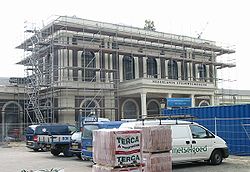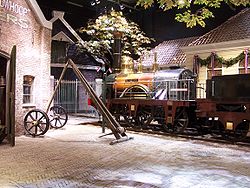
Nederlands Spoorwegmuseum
Encyclopedia

Netherlands
The Netherlands is a constituent country of the Kingdom of the Netherlands, located mainly in North-West Europe and with several islands in the Caribbean. Mainland Netherlands borders the North Sea to the north and west, Belgium to the south, and Germany to the east, and shares maritime borders...
national railway museum
Museum
A museum is an institution that cares for a collection of artifacts and other objects of scientific, artistic, cultural, or historical importance and makes them available for public viewing through exhibits that may be permanent or temporary. Most large museums are located in major cities...
. It was established in 1927; since 1954 it has been housed in the "Maliebaan station", a former station in Utrecht
Utrecht (city)
Utrecht city and municipality is the capital and most populous city of the Dutch province of Utrecht. It is located in the eastern corner of the Randstad conurbation, and is the fourth largest city of the Netherlands with a population of 312,634 on 1 Jan 2011.Utrecht's ancient city centre features...
.
History
The museum was established in 1927 and was initially located in one of the main buildings of the Nederlandse SpoorwegenNederlandse Spoorwegen
Nederlandse Spoorwegen , or NS, is the principal passenger railway operator in the Netherlands.Its trains operate over the tracks of the Dutch national railinfrastructure, operated by ProRail, which was split off from NS in 2003...
(Dutch National Railroad) in Utrecht
Utrecht (city)
Utrecht city and municipality is the capital and most populous city of the Dutch province of Utrecht. It is located in the eastern corner of the Randstad conurbation, and is the fourth largest city of the Netherlands with a population of 312,634 on 1 Jan 2011.Utrecht's ancient city centre features...
. At that time, the collection consisted mostly of pictures, documents, and small objects. In the 1930s the first steps were taken to conserve old historically significant rail equipment. A portion of this collection was lost during World War II
World War II
World War II, or the Second World War , was a global conflict lasting from 1939 to 1945, involving most of the world's nations—including all of the great powers—eventually forming two opposing military alliances: the Allies and the Axis...
.
The Maliebaan station
The collection was briefly located in the Rijksmuseum in AmsterdamAmsterdam
Amsterdam is the largest city and the capital of the Netherlands. The current position of Amsterdam as capital city of the Kingdom of the Netherlands is governed by the constitution of August 24, 1815 and its successors. Amsterdam has a population of 783,364 within city limits, an urban population...
, but in the 1950s the museum was moved back to Utrecht. The Maliebaan station, which was closed in 1939, was found to be a suitable site. The building was remodeled, and in 1954 the museum reopened there. In this location there was far more room to exhibit the entire collection to the public, including historical rail equipment. Until 2003, a long line of historic steam locomotive
Steam locomotive
A steam locomotive is a railway locomotive that produces its power through a steam engine. These locomotives are fueled by burning some combustible material, usually coal, wood or oil, to produce steam in a boiler, which drives the steam engine...
s on track one of the station was one of the most distinctive aspects of the exhibit.
Expansion and renovation
Over the years, more rail equipment and also tramTram
A tram is a passenger rail vehicle which runs on tracks along public urban streets and also sometimes on separate rights of way. It may also run between cities and/or towns , and/or partially grade separated even in the cities...
equipment was added to the museum, and in the 1960s the plaza in front of the building was filled with rolling stock, which suffered much from the weather. An initial improvement, in 1975, was the construction of a roofed platform behind the building. In 1977 the museum was expanded with a pedestrian bridge, allowing access to an exhibit area on the other side of the freight rail tracks behind the main building. The space in front of the building was then converted to a parking lot.
The right wing of the main building contained the "historic" department, with the "modern" department located in the left wing. Among the distinctive parts of the collection are models of bridges from early on in the development of the Dutch railroads, and models of various train types. In addition there are paintings, prints, and railway equipment to be seen. The "modern" section was changed in the 1980s when it was updated to include the most recent developments, including the front of a "Sprinter" train.
Between 1988 and 1989 a major renovation was undertaken. The interior of the station building was completely redone according to the modern views of that time. This version was in place through 2003. In addition, the back lot was integrated into the museum and a "railway landscape" was built there. It also became possible to take rides, both in model trains and full sized ones. Additional buildings were added, such as the signal house from Hoogezand-Sappemeer, and a crossing guard house from Elst (in the province of Gelderland). One of the oldest railroad bridges, from Halfweg, was also included. Finally, rail service between the main railroad station of Utrecht and the Maliebaan station(the museum) was established.
Later additions, in the 1990s, were two cargo barns, one of which now houses a restaurant, and a new building on the back lot with a large model railroad. The growing collection of rolling stock was largely restored, and partly returned to operating condition. Some of the trains had suffered due to being stored out in the open, so there has been an ongoing effort to have the entire exhibit area roofed over.
The most recent major remodeling

The Hague
The Hague is the capital city of the province of South Holland in the Netherlands. With a population of 500,000 inhabitants , it is the third largest city of the Netherlands, after Amsterdam and Rotterdam...
, which was demolished in 1973.
Sections of the station building
- Station hall
- Freight hall
- Dining room
- Waiting room, 3rd class
- Waiting room, 1st and 2nd class
- Royal waiting room
The new building
During the 2002 remodeling, the back lot was also largely cleared, and completely renovated. A large new museum building was constructed, which now contains four "worlds":- The great discovery (the early years in the 19th century)
- Dream travels (the glory days of international trains around 1900)
- Steel monsters (the 1930s and 1940s)
- The workshop (large hall with trains)
The presentation was redesigned to appeal much more to the general public, especially visitors with children, and to be interesting for corporate events and the like. The technical and historical substance of the museum has become a lower priority. The collection now serves mainly as a kind of "background" for visitors.
Much attention was given to decoration. The choice was made to offer "a little of everything" to appeal to the general public. judging from the sharp increase in attendance since the reopening in June 2005, it would seem this goal has been achieved.
Sections of the new building

- Conference hall and foyer
- The Open Depots
- Automated Audio Tour "world 1"
- Theater "world 2"
- Track "world 3"
- Plaza "world 4"
- Warehouse "Nijverdal"
- Model Trains Cellar
- Exhibition Area
- Museum Shop
- Restaurant
Outdoors exhibit area
On the exhibit area outside, a water tower was added near the existing signal house. There is also a model railway, a children's playground, and an area for special events, as well as a turntableTurntable (railroad)
A railway turntable is a device for turning railroad rolling stock. When steam locomotives were still in wide use, many railroads needed a way to turn the locomotives around for return trips as their controls were often not configured for extended periods of running in reverse and in many...
.
Rolling stock collection
The museum currently owns a large and varied collection of rolling stock. The collection is too large to be shown in full in the limited space available. For this reason, most of the trams were dropped from the collection in the 1990s, and some of the trains are in storage. The remaining collection is no longer shown by category, as was formerly the practice, but is placed more or less at random.The collection currently on display contains, among other things, steam locomotive
Steam locomotive
A steam locomotive is a railway locomotive that produces its power through a steam engine. These locomotives are fueled by burning some combustible material, usually coal, wood or oil, to produce steam in a boiler, which drives the steam engine...
s, electric locomotive
Electric locomotive
An electric locomotive is a locomotive powered by electricity from overhead lines, a third rail or an on-board energy storage device...
s, diesel locomotive
Diesel locomotive
A diesel locomotive is a type of railroad locomotive in which the prime mover is a diesel engine, a reciprocating engine operating on the Diesel cycle as invented by Dr. Rudolf Diesel...
s, train cars, freight cars, and some trams.
Overview of the collection
Some of the items in the collection are:- Steam locomotives, for example:
- The ArendArendArend was one of the two first steam locomotives in the Netherlands. It was a 2-2-2 Patentee type built in England by R. B. Longridge and Company of Bedlington, Northumberland. On 20 September 1839, together with the Snelheid , it hauled the first train between Amsterdam and Haarlem...
("Eagle"), the first Dutch locomotive (replica) - WD 73755 Longmoor (NS 5085; WD Austerity 2-10-0)
- Locomotive no. 3737, the last steam locomotive in Dutch railroad service (retired 1958)
- The Arend
- Motor-railcar mBC 6, built in 1908, the first Dutch electrically powered train
- A Royal rail car
- A crane
Shuttle rail service between Utrecht central station and the Maliebaan station
As part of the reopening of the renovated museum in June 2005, it was also reopened as a train station for the first time in almost 66 years. There is now train service on an hourly basis, Tuesday through Sunday (and Monday during holiday periods), between the museum and the Utrecht central stationUtrecht Centraal railway station
Utrecht Centraal is the central railway station for the city of Utrecht in the Netherlands. It is the largest railway station in the Netherlands in terms of size, with fourteen platforms With Utrecht being located centrally in the Netherlands, Utrecht Centraal is also the largest station in terms...
.

